Menus
- Trip with the Honda classic
- It’s just great how light-footed the CBX is
- Athletes with all-round talent
- F2 four kilograms heavier
- Experienced motorcycle history
- Opinion from the owner of the Honda CBX 550 F2
- In detail: Honda CBX 550 F2
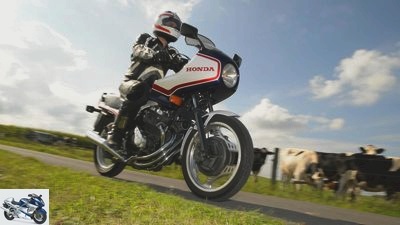
Fred Siemer, Archive, Honda
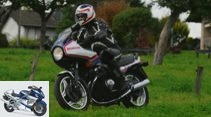
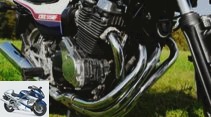
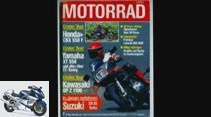
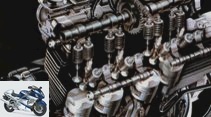
18th photos
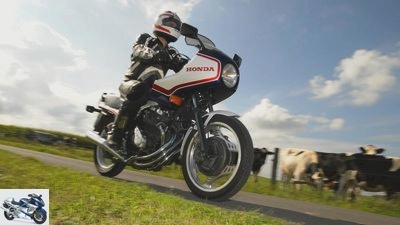
Fred Siemer, Archive, Honda
1/18
On the move with the Honda CBX 550 F2.
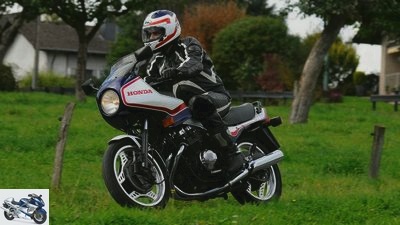
Fred Siemer, Archive, Honda
2/18
The Honda turned out to be an all-round talent.
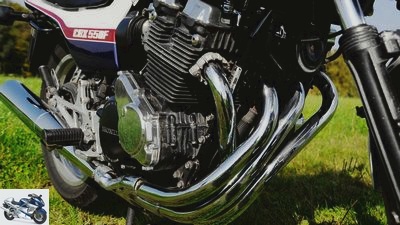
Fred Siemer, Archive, Honda
3/18
The tangle is not only beautiful, it even makes sense: all the bends are exactly the same length up to the collectors.
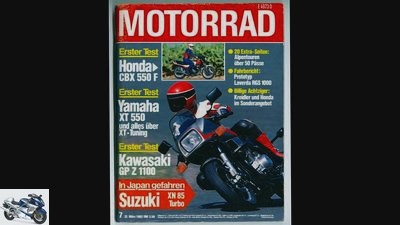
Fred Siemer, Archive, Honda
4/18
MOTORRAD welcomed the CBX 550 in 1982…
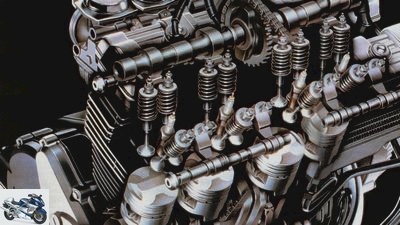
Fred Siemer, Archive, Honda
5/18
…as the latest state of the art: Inline-dohc-Four, rocker arm and compact combustion chamber.
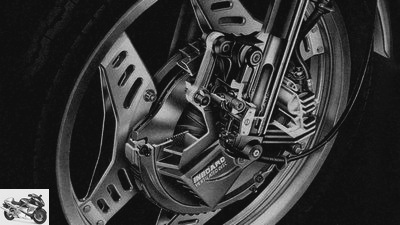
Fred Siemer, Archive, Honda
6/18
The left fork leg carries the not entirely ineffective anti-dive system.
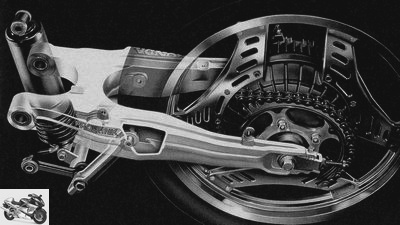
Fred Siemer, Archive, Honda
7/18
Real progress compared to early Honda four-cylinder models: the stable, needle-bearing aluminum rear swing arm with sensitive, progressively working Pro-Link.

Fred Siemer, Archive, Honda
8/18
Why easy The cast iron brake disc (above) is completely covered by a rim (right) and a cover (with ventilation openings) made of aluminum. On the other hand, the same thing, every wheel removal becomes a challenge.
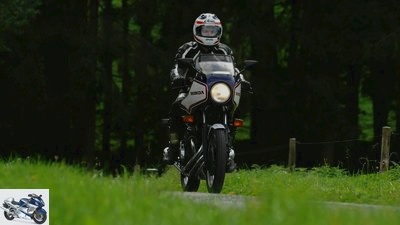
Fred Siemer, Archive, Honda
9/18
Experienced motorcycle history. That’s it, isn’t it? Very small weaknesses included.
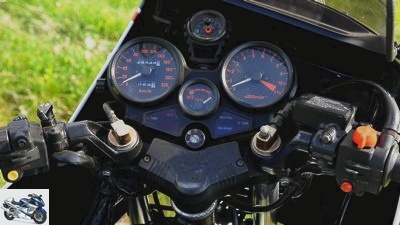
Fred Siemer, Archive, Honda
10/18
Red area at 10,500 rpm, that was sport. On the right of the fork stopper valve for inflating the air cushion.
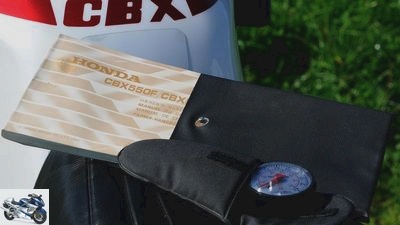
Fred Siemer, Archive, Honda
11/18
Belongs to the original condition: Honda added a pressure gauge to the usual modest on-board tools.

Fred Siemer, Archive, Honda
12/18
At the beginning of the 1980s, such fork stabilizers were actually only available from Fritz W. Egli in his high-end racers.
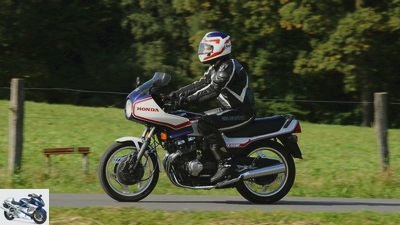
Fred Siemer, Archive, Honda
13/18
Enormous turning ability and service friendliness.
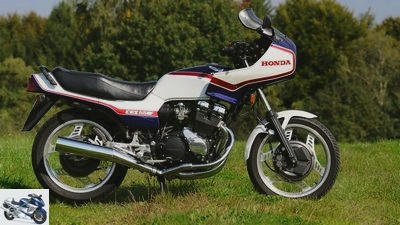
Fred Siemer, Archive, Honda
14/18
In 1982 the Honda was available for 7063 marks.
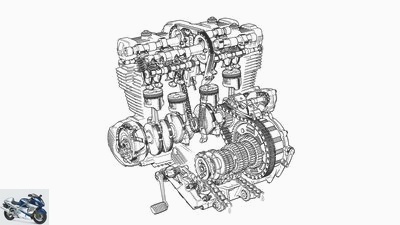
Fred Siemer, Archive, Honda
15/18
The will for a compact construction is visible, only the central timing chain and Lima still cost the overall width.
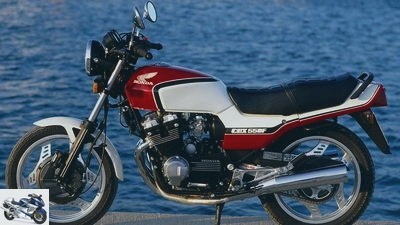
Fred Siemer, Archive, Honda
16/18
1981: At the end of this year, the CBX 550 F is presented as an undisguised athlete. Just one year later, the disguised variant called F2 appeared in response to popular requests from customers.

Fred Siemer, Archive, Honda
17/18
Christian Hesse (28), part-time owner of the CBX 550 F2…
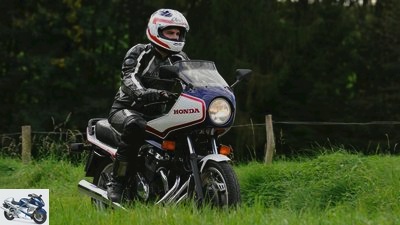
Fred Siemer, Archive, Honda
18/18
…"It does not pose any puzzles to anyone and is still a very dedicated motorcycle."
On the move with the Honda CBX 550 F2
Trip with the Honda classic
Content of
Of all the young timers that are more in the shadows, the Honda CBX 550 F2 probably deserves this fate the least. MOTORRAD Classic was able to marvel at and move one of these techno bikes, which are rare today.
E.inst there was a time when Honda never let its butter be stolen from its bread. Always storming forward in high gear, the industry leader surprised his competition again and again with great concepts, and if the others were faster, they had to expect a particularly ingenious return coach. So it happened to Kawasaki, whose GPZ 550 very successfully defined a new sporty middle class from spring 1981. Before that, all four Japanese had simply increased the classic half-liter displacement and noticeably gained traction. The GPZ now broke the 50 hp mark that had been customary up until then, and because both dimensions and weight remained low, it was initially 58, then 62 lively little horses enough to play cat and mouse on the country road with the 1000-cc superbike heavyweights of the time . The customers found it fascinating and chose the dynamic middle-grader as a popular investment destination.
Buy complete article
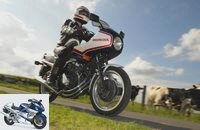
On the move with the Honda CBX 550 F2
Trip with the Honda classic
Honda’s return carriage
In contrast, the world market leader was rather negatively impressed. Because he couldn’t play along. His old ohc-CB 550 was considered completely exhausted, and the current CX 500 appealed to a different target group despite somehow sporting talent. So do it again. Once again, chief developer Hiroshi Kameyama was allowed to arrange everything in a row, but his four-cylinder CBX 550 F, presented at the end of 1981, had nothing to do with the half-liter Hondas that had been sold for ten years, from the oil drain plug to the cylinder cover. As with the six-cylinder 1000, the X in the name referred to four valves per combustion chamber. In accordance with the standard of that time, they were operated by two chain-driven camshafts, but not, as is usually the case, with bucket tappets, but very service-friendly via light, forked rocker arms. Each valve has its own cute adjusting screw. That in turn corresponds to today’s standard.
Fred Siemer, Archive, Honda
In 1982 the Honda was available for 7063 marks.
The compact combustion chamber is just as modern. The angle between the 23-millimeter intake and 20-millimeter exhaust valves measures just 38 degrees, and a roof-shaped combustion chamber is formed by a prominent elevation on the piston crown – Pentroof, patented by Honda. It ensures short flame paths and thus fast, even combustion. Unfortunately, due to the narrow space in the upper room, it can get pretty hot, and that’s why Honda bought an oil cooler from the start, a second, narrower oil pump rotor pumps part of the lubricant there directly from the oil pan.
It’s just great how light-footed the CBX is
As with previous Honda in-line four-cylinders, a toothed chain passes the engine power on, but now without an intermediate shaft directly to the clutch basket. Is that because of the lively temperament with which the finely ribbed Four reacts to gas blows while standing and hisses from its intricate four-in-two system? You can’t hear it often enough, but before this gets embarrassing, it has to be good: After a short shift, the first engages, the smooth and sensitive clutch creates the frictional connection, dry stepped up twice, the Honda CBX 550 purrs hoarsely from the residential area. Got quite tame, suddenly. The Honda people couldn’t do magic either: their engine has already been on the gas for just over 1,000 revolutions, takes the mixture from the 25 mm Keihin constant pressure carburetors without swallowing, but develops only a gentle forward thrust below 3,500 revolutions. This is followed by an extremely civilized work area, up to almost 7,000 rpm, which is suitable for all everyday stuff.
Fred Siemer, Archive, Honda
The tangle is not only beautiful, it even makes sense: all the bends are exactly the same length up to the collectors.
Only then does the sports show begin: It’s just great how light-footed the Honda CBX 550 is. In the third, in a tight bend, tap open, the fourth already fits the curve exit. Fifth is always there on the straight, because the CBX loses its fighting spirit in the last gear: The standard final gear ratio is too long, which is why the Honda in the first MOTORRAD group test – which, incidentally, it won against the Kawasaki GPZ 550 and Yamaha XZ 550 – reached the two-person top speed in fifth gear. 165 km / h at 8870 rpm. Solo long it made it in the sixth 191 at a good 9000, so it was still well below the rated speed.
Athletes with all-round talent
A comparison test later, things looked a little different, because the Honda CBX 550 F2, which was offered at the same time and for around 900 Marks extra, was already there. That ended at a good 180 km / h. Why? Because Honda had jumped on the bandwagon and given it a chic, but rather towering half-shell. By the way, the photo model on these pages is a hermaphrodite, received the paneling later, but was still allowed to keep the side cover with simple F lettering.
Fred Siemer, Archive, Honda
Belongs to the original condition: Honda added a pressure gauge to the usual modest on-board tools.
The paneling ensures increased comfort, even taller people feel well protected. In addition, there is a harmonious seating arrangement for small to not very large statures, and the desire to travel is already evident. You want to start right now, from the Rhine near Cologne to over the Alps. 18 liters of tank capacity, almost six liters of fuel consumption on country roads, tolerable vibrations (and only those in certain speed ranges), high suspension comfort, nice pillion seat – from today’s point of view, it must be astonishing how well this little athlete appears. Of course, he also carries the main stand, something that not even every designated excursion boat currently has.
F2 four kilograms heavier
Despite this equipment offensive, Kameyama-San managed to freeze the combat weight at 209 kilograms with a full tank, the disguised Honda CBX 550 F2 dragged around four kilograms more. A gift, because it also impresses with wonderful ease. The few pounds were also well distributed, after just three or four turns the driver can feel how well balanced the CBX is. Front and rear it rolls on 18-inch Comstar composite wheels, both with only moderately wide tires. At the front there is a sensitive, appealing 35 mm fork, with an anti-dive system in the left column, which was unavoidable at the time. If you want a harder suspension, you can increase the air pressure in the bars. However, if he exaggerates, heavy pressure on the fork seals prevents sensitive response. The rear wheel rotates in a cast aluminum swing arm, which is supported against the frame via a lever and central spring strut. Honda Pro-Link, sure. Of course, you can also play with air pressure here and thus adjust the load to a higher load. Honda even included a pressure gauge for possible checks.
Fred Siemer, Archive, Honda
Red area at 10,500 rpm, that was sport. On the right of the fork stopper valve for inflating the air cushion.
Fully adjustable dampers have proven to be much more effective on motorcycles in the CBX 550 weight class, so blowing exercises like this are long history there. Fortunately, and actually this Honda feels most comfortable under a soloist when you exert as little pressure as possible on it in front and behind. Then it still maintains enough comfort on a bad road, without teetering helplessly through fast, undulating corners. So further in the text: Their steering precision is convincing in both narrow and wide radii. The machine does not fall into the corner, but follows the steering commands very reliably and stays on course. One single bad habit spoils the handling: Anyone who lets go of the handlebars between 60 and 70 km / h will witness violent fidgeting. Without external stimulation, the Honda CBX 550 shows strong shimmy. This isn’t really dangerous if you are prepared for it and can usually be fixed with a precise steering head bearing. Incidentally, this truck was widespread at the time, and the Japanese also had to get used to the tight manufacturing tolerances that light and strong motorcycles require when building frames.
Experienced motorcycle history
That’s it, isn’t it? Let it fidget a little, the great Honda CBX 550. Is it still fun – or is it because of that? – How crazy. Her tachometer is going round, the gearbox is at full capacity, the brakes are on alert. Honda has given the lightweight three excellently metered disc brakes that are energetic even by today‘s standards. They also represent a piece of motorcycle history: At the beginning of the 1980s, cast washers still offered some advantages in wet and hot conditions. Unfortunately, and that could be seen on every Guzzi, the things rust almost overnight. That’s not tragic, it just looks gross – and annoyed the pedantic Japanese so much that they gave the CBX encapsulated disc brakes.
Fred Siemer, Archive, Honda
Real progress compared to early Honda four-cylinder models: the stable, needle-bearing aluminum rear swing arm with sensitive, progressively working Pro-Link.
The V-twin all-rounder VT 500, which was released a little later, has the same decoration, but with only one disc at the front and drum at the rear. Here as there, the braking effect was flawless, but severe criticism always arises when the bike has to get out. And even more so when the sintered metal pads in the two double-piston brake calipers are due in front. Which is why this paragraph ends with a “Fortunately”: Fortunately, steel discs now brake perfectly. At the same time, there are now customizers who like the encapsulated Honda things for visual reasons. Because they are so similar to drum brakes. Therefore, some Honda CBX 550 are said to be lying and rotting at the motorcycle butcher. You want to cry, but not even a Honda can ride a bike.
Opinion from the owner of the Honda CBX 550 F2
Christian Hesse (28), part-time owner of the Honda CBX 550 F2
Fred Siemer, Archive, Honda
Christian Hesse (28).
I am fortunate to have grown up in a motorcycle-crazy family, and from my father’s small, fine Honda collection, I particularly like the Honda CBX 550 F2. It does not pose any puzzles to anyone and is still a very dedicated motorcycle. It’s amazing that your over 35 year old Four can do more than just survive today. I think he is convincing, with his civilized run and great revving. That turns me on more than any beefy twin.
In detail: Honda CBX 550 F2
Technical specifications
Engine: Air-cooled four-cylinder four-stroke in-line engine, two overhead camshafts, four valves per cylinder, actuated via fork rocker arms, displacement 572 cm³, output 44 kW (60 hp) at 10,000 rpm. Power transmission: multi-disc oil bath clutch, six-speed gearbox, chain drive
Landing gear: Double loop frame made of tubular steel, air-assisted telescopic fork at the front, Ø 35 mm, twin-arm swing arm made of cast aluminum, deflection, air-assisted central spring strut, composite wheels, tires 90/90 x 18 at the front, 110/80 x 17 at the rear, encapsulated double disc brake at the front, Ø 226 mm, double-piston floating caliper, Rear disc brake, Ø 226 mm
Mass and weight: Wheelbase 1,380 mm, weight with a full tank 213 kg
Driving performance: Top speed 180 km / h
Fred Siemer, Archive, Honda
The will for a compact construction is visible, only the central timing chain and Lima still cost the overall width.
technology
Unlike the engineers at Kawasaki, who upgraded their well-known 500 to the 550, and the Yamaha people who were still troubled by the XS 500 problems with the XJ 550, Honda consistently relied on four-valve technology. And sometimes gave away the resulting advantages when pulling through with a much too long secondary transmission. What remained Enormous turning power.
Also service-friendliness thanks to the fork rocker arms used. The drive chain for the two camshafts, which is arranged in the middle, was also rarely taken care of; an automatic chain tensioner ensures correct tension. In order not to put anything useless in the way of the gas flow, Honda did without a choke valve on the carburetors. Instead – which was still unusual at the time – integrated starter carburetors enrich the mixture. As with the old Honda Fours, the alternator sits on the left crankshaft stub. Nevertheless, the CBX engine can be called a milestone on the way to the high-performance four-cylinder. It has shifted performance and weight standards. The latter also applies to the more conventionally drawn frame, because the construction with a strong top tube and two closed beams relies on very thin-walled tubes and allegedly saved over 15 percent weight compared to traditional frames. The cast aluminum swingarm with needle bearings was subject to the same austerity requirements, and the Comstar wheels don’t weigh the world either.
Used check
Although it was one of the coveted and technically respected light athletes in its time, the Honda CBX 550 was soon passed as a middle class. In the end, many copies ended up with drivers who simply want a cheap motorcycle and invest little in maintenance. With the exception of visible collector’s items, listen carefully to suspicious engine noises. Although the CBX is not entirely unfamiliar with damage to the crankshaft bearings, a defective timing chain tensioner usually causes rattling noises. All bearings of the chassis should be checked just as meticulously, including those of the Pro-Link lever. A precision bearing in the steering head is an absolute plus, otherwise the chassis does not need to be upgraded. If previous owners have played too hard with the air pressure, the fork seals can quickly leak. Finally, a careful visual and auditory inspection of the exhaust system applies. Both sides are made in one piece, and the weld seams around the collector are particularly susceptible to rust. The characteristic four-in-two system is now one of the most difficult to obtain CBX parts. Also rare: body parts and the tank.
market
Of the 6,300 Honda CBX 550 (both versions together) sold in Germany, only a few are likely to roll on our streets. The thin offer seems to spur price drivers on: Very rarely is a CBX 550 offered that is worth the amount asked. And that should be 1,500 to 2,000 euros for a complete copy in its original condition with a mileage of around 60,000 kilometers, well-cared for collector’s items may cost up to a maximum of 1,000 euros more. The Honda CBX 550 F2 with its distinctive fairing is a bit more sought-after, less popular in Germany is the 50-hp version throttled by camshafts and main jets.
Club
The active German club meets at www.cbx550club.de
Related articles
-
Comparison test: Honda CX 500-650 Turbo, Kawasaki Z 750 Turbo, Suzuki XN 85, Yamaha XJ 650 Turbo
Jahn 21 pictures Jahn 1/21 The preload of the central spring strut of the Suzuki can be easily adjusted. Jahn 2/21 Tight corners and fast …
-
On the move: the Honda VF 500 F II and Yamaha RD 500 LC
fact On the move: Honda VF 500 F II and Yamaha RD 500 LC Extreme athletes Contents from the beginning of 1984, the Honda VF 500 F II and Yamaha RD 500 LC …
-
Comparison Honda Hornet-Suzuki GSF 600 Bandit
Comparison Honda Hornet / Suzuki GSF 600 Bandit En garde In the duel between Hornet and Bandit, the choice of weapons is a matter of form. The outcome of the …
-
fact 12 pictures fact 1/12 Top brakes: radially screwed six-piston stoppers, ABS and integral actuation. fact 2/12 Builds compact and very narrow: the …
-
Top-Test Honda Deauville She is one of those There are only a few motorcycles that can do almost everything from the factory except online banking. But maybe she learns …
-
Single cylinder in comparison: Honda XBR 500 and Yamaha SRX 6
Bilski On the move: Honda XBR 500 and Yamaha SRX 6 single-cylinder in comparison: Honda XBR 500 and Yamaha SRX 6 Contents of Is less motorcycle more fun? …
-
Comparison test of the sports tourers from BMW and Honda
fact 12 pictures fact 1/12 Top brakes: radially screwed six-piston stoppers, ABS and integral actuation. fact 2/12 Builds compact and very narrow: the …
-
factstudio.de 15th photos factstudio.de 1/15 Honda CB 1000 R + in the top test. factstudio.de 2/15 The design line of the new CB 1000 R is called “Neo…
-
Gargolov Final Honda NSR 250 SE Two-stroke in perfection It appeared in late 1993 and was barely noticed outside of Japan. But those who drove motorcycle…
-
Driving report Honda Deauville
Photos: Markus Jahn Driving report Honda Deauville (2006) Relax, just do it If Frankie goes to Hollywood, he can do so on the Harley. Better to change…